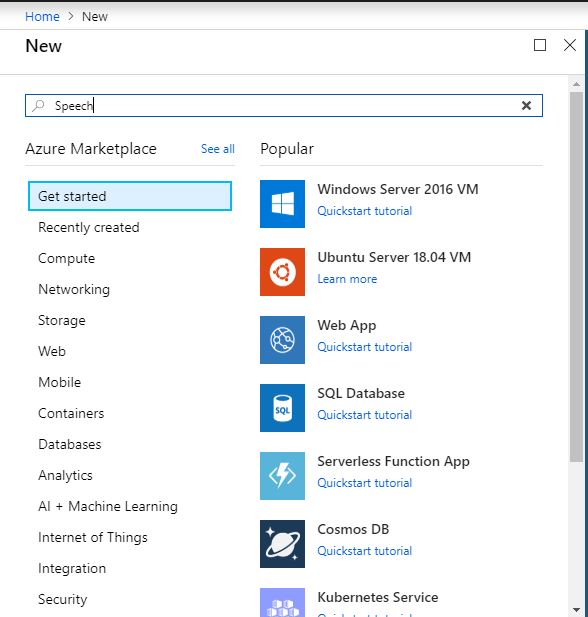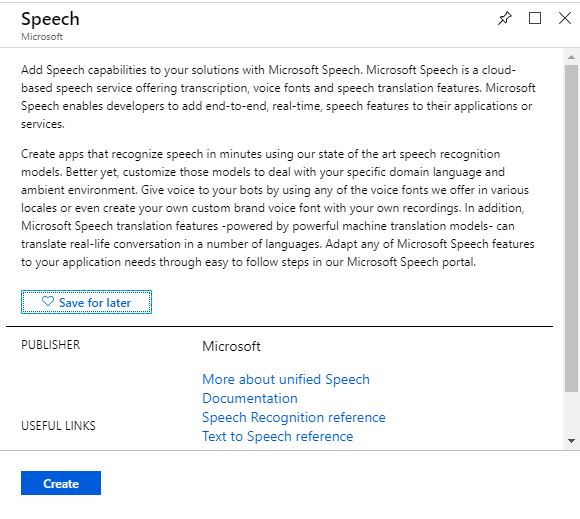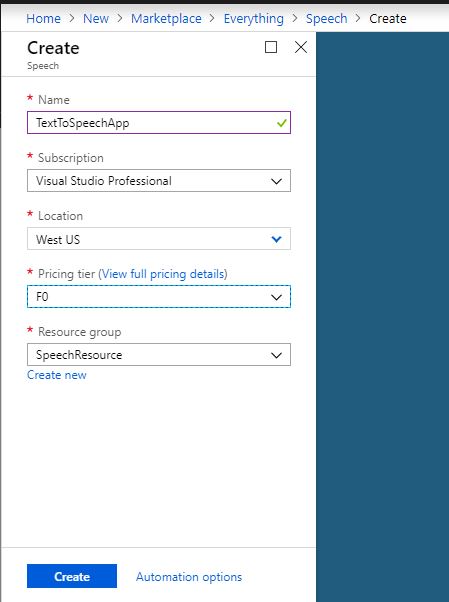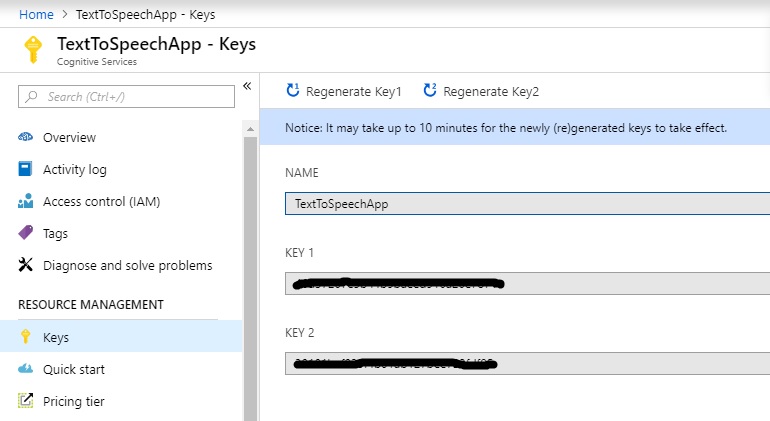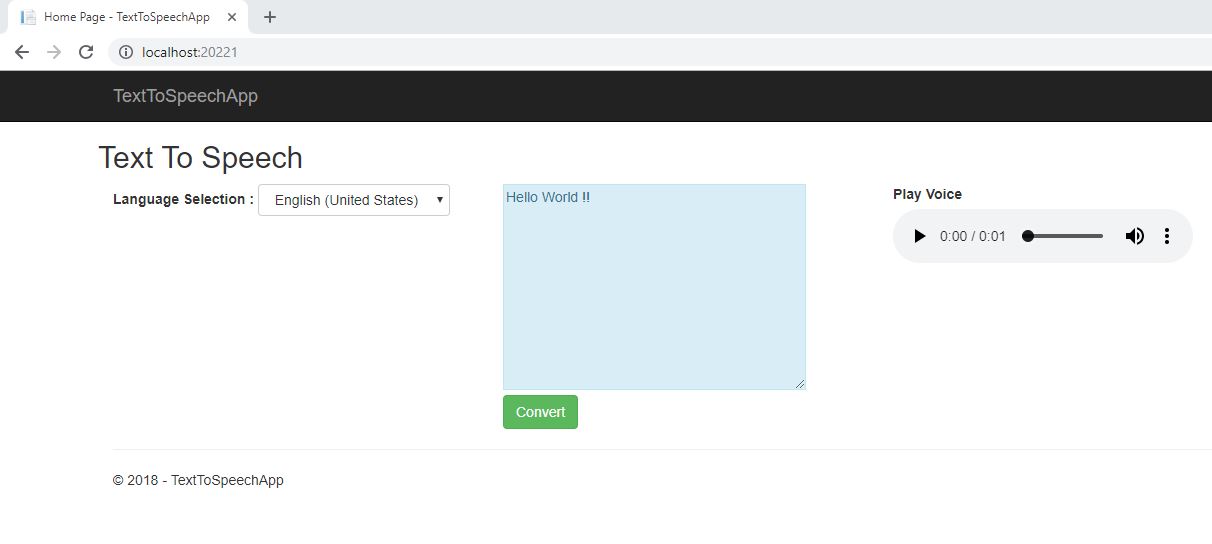Cognitive Services : Convert Text to Speech in multiple languages using Asp.Net Core & C#
Introduction
In this article, we are going to learn how to convert text to speech in multiple languages using one of the important Cognitive Services API called Microsoft Text to Speech Service API ( One of the API in Speech API ). The Text to Speech (TTS) API of the Speech service converts input text into natural-sounding speech (also called as speech synthesis). It supports text in multiple languages and gender based voice(male or female).
You can also refer the following articles on Cognitive Service.
- Cognitive Services : Translate Text into multiple languages using Translator Text API With Asp.Net Core & C#
- Cognitive Services : Analyze an Image Using Computer Vision API
- Cognitive Services – Optical Character Recognition (OCR) from an image using Computer Vision API And C#
- Cognitive Services : Extract handwritten text from an image using Computer Vision API With ASP.NET Core And C#
- Cognitive Services : Analyze an Image Using Computer Vision API
- Cognitive Services – Optical Character Recognition (OCR) from an image using Computer Vision API And C#
- Cognitive Services : Extract handwritten text from an image using Computer Vision API With ASP.NET Core And C#
Prerequisites
- Subscription key ( Azure Portal ) or Trail Subscription Key.
- Visual Studio 2015 or 2017
Convert Text to Speech API
First, we need to log into the Azure Portal with our Azure credentials. Then we need to create an Azure Speech Service API in the Azure portal. So please click on the “Create a resource” on the left top menu and search “Speech” in the search bar on the right side window or top of Azure Marketplace.
Now we can see there are few speech related “AI + Machine Learning ” categories listed in the search result.
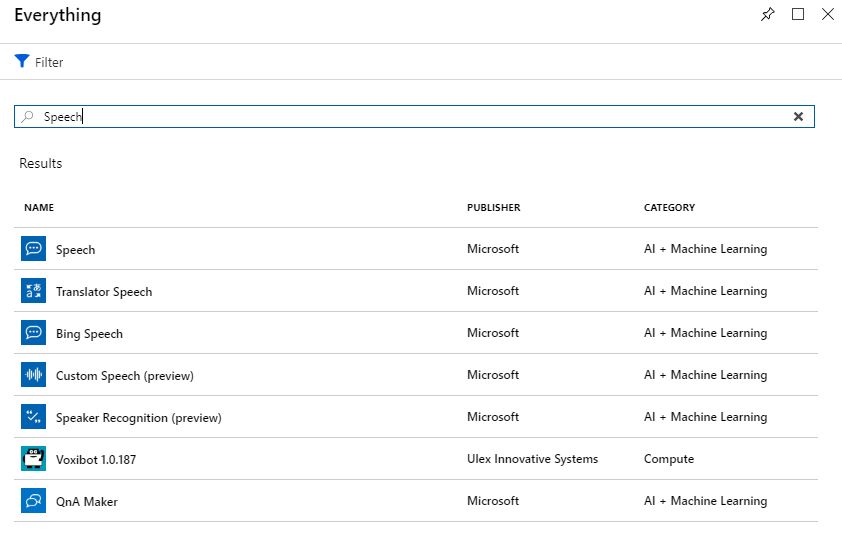
Click on the “create” button to create Speech Service API.
Provision a Speech Service API ( Text to Speech ) Subscription Key
After clicking the "Create", It will open another window. There we need to provide the basic information about Speech API.
Name : Name of the Translator Text API ( Eg. TextToSpeechApp ).
Subscription : We can select our Azure subscription for Speech API creation.
Location : We can select location of resource group. The best thing is we can choose a location closest to our customer.
Pricing tier : Select an appropriate pricing tier for our requirement.
Resource group : We can create a new resource group or choose from an existing one ( We created a new resource group as "SpeechResource" ).
Now click on the "TextToSpeechApp" in dashboard page and it will redirect to the detailed page of TextToSpeechApp ( "Overview" ). Here, we can see the "Keys" ( Subscription key details ) menu in the left side panel. Then click on the "Keys" menu and it will open the Subscription Keys details. We can use any of the subscription keys or regenerate the given key for text to speech conversion using Microsoft Speech Service API.
Authentication
A token ( bearer ) based authentication is required in the Text To Speech conversion using Speech Service API. So we need to create an authentication token using "TextToSpeechApp" subscription keys. The following "endPoint" will help to create an authentication token for Text to speech conversion. The each access token is valid for 10 minutes and after that we need to create a new one for the next process.
***"https://westus.api.cognitive.microsoft.com/sts/v1.0/issueToken;"
Speech Synthesis Markup Language ( SSML )
The Speech Synthesis Markup Language (SSML) is an XML-based markup language that provides a way to control the pronunciation and rhythm of text-to-speech. More about SSML .
SSML Format :
<speak version='1.0' xml:lang='en-US'><voice xml:lang='ta-IN' xml:gender='Female' name='Microsoft Server Speech Text to Speech Voice (ta-IN, Valluvar)'>
நன்றி
</voice></speak>
How to make a request
This is very simple process, HTTP request is made in POST method. So that means we need to pass secure data in the request body and that will be a plain text or a SSML document. As per the documentation,it is clearly mentioned in most cases that we need to use SSML body as request. The maximum length of the HTTP request body is 1024 characters and the following is the endPoint for our http Post method.
***"https://westus.tts.speech.microsoft.com/cognitiveservices/v1"
The following are the HTTP headers required in the request body.
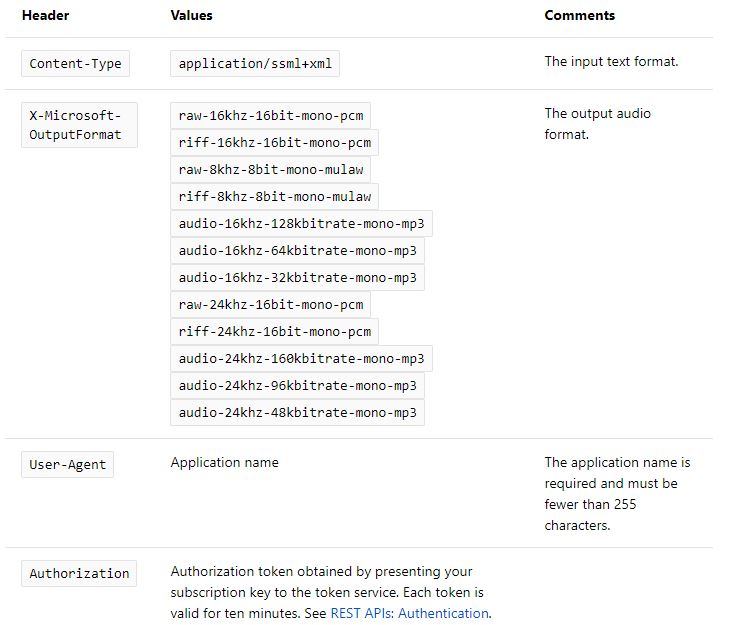
Pic source : https://docs.microsoft.com/en-us/azure/cognitive-services/speech-service/how-to-text-to-speech
Index.html
The following html contains the binding methodology that we have used in our application by using the latest Tag helpers of ASP.Net Core.
Model
The following model contains the Speech Model information.
using Microsoft.AspNetCore.Mvc.Rendering;
using System.Collections.Generic;
using System.ComponentModel;
namespace TextToSpeechApp.Models
{
public class SpeechModel
{
public string Content { get; set; }
public string SubscriptionKey { get; set; } = "< Subscription Key >";
[DisplayName("Language Selection :")]
public string LanguageCode { get; set; } = "NA";
public List<SelectListItem> LanguagePreference { get; set; } = new List<SelectListItem>
{
new SelectListItem { Value = "NA", Text = "-Select-" },
new SelectListItem { Value = "en-US", Text = "English (United States)" },
new SelectListItem { Value = "en-IN", Text = "English (India)" },
new SelectListItem { Value = "ta-IN", Text = "Tamil (India)" },
new SelectListItem { Value = "hi-IN", Text = "Hindi (India)" },
new SelectListItem { Value = "te-IN", Text = "Telugu (India)" }
};
}
}
Interface
The "ITextToSpeech" contains one signature for converting text to speech based on the given input. So we have injected this interface in the ASP.NET Core "Startup.cs" class as a "AddTransient".
using System.Threading.Tasks;
namespace TextToSpeechApp.BusinessLayer.Interface
{
public interface ITextToSpeech
{
Task<byte[]> TranslateText(string token, string key, string content, string lang);
}
}
Text to Speech API Service
We can add the valid Speech API Subscription key and authentication token into the following code.
///
<summary>
/// Translate text to speech
/// </summary>
/// <param name="token">Authentication token</param>
/// <param name="key">Azure subscription key</param>
/// <param name="content">Text content for speech</param>
/// <param name="lang">Speech conversion language</param>
/// <returns></returns>
public async Task<byte[]> TranslateText(string token, string key, string content, string lang)
{
//Request url for the speech api.
string uri = "https://westus.tts.speech.microsoft.com/cognitiveservices/v1";
//Generate Speech Synthesis Markup Language (SSML)
var requestBody = this.GenerateSsml(lang, "Female", this.ServiceName(lang), content);
using (var client = new HttpClient())
using (var request = new HttpRequestMessage())
{
request.Method = HttpMethod.Post;
request.RequestUri = new Uri(uri);
request.Headers.Add("Ocp-Apim-Subscription-Key", key);
request.Headers.Authorization = new AuthenticationHeaderValue("Bearer", token);
request.Headers.Add("X-Microsoft-OutputFormat", "audio-16khz-64kbitrate-mono-mp3");
request.Content = new StringContent(requestBody, Encoding.UTF8, "text/plain");
request.Content.Headers.Remove("Content-Type");
request.Content.Headers.Add("Content-Type", "application/ssml+xml");
request.Headers.Add("User-Agent", "TexttoSpeech");
var response = await client.SendAsync(request);
var httpStream = await response.Content.ReadAsStreamAsync().ConfigureAwait(false);
Stream receiveStream = httpStream;
byte[] buffer = new byte[32768];
using (Stream stream = httpStream)
{
using (MemoryStream ms = new MemoryStream())
{
byte[] waveBytes = null;
int count = 0;
do
{
byte[] buf = new byte[1024];
count = stream.Read(buf, 0, 1024);
ms.Write(buf, 0, count);
} while (stream.CanRead && count > 0);
waveBytes = ms.ToArray();
return waveBytes;
}
}
}
}
Download
Output
The given text is converted into speech in desired language listed in a drop-down list using Microsoft Speech API.
Demo
Reference
Summary
From this article we have learned how to convert text to speech in multiple languages using Asp.Net Core & C# as per the API documentation using one of the important Cognitive Services API ( Text to Speech API is a part of Speech API ). I hope this article is useful for all Azure Cognitive Services API beginners.
See Also
It's recommended to read more articles related to ASP.NET Core & Azure App Service:
- ASP.NET CORE 1.0: Getting Started
- ASP.NET Core 1.0: Project Layout
- ASP.NET Core 1.0: Middleware And Static files (Part 1)
- Middleware And Staticfiles In ASP.NET Core 1.0 - Part Two
- ASP.NET Core 1.0 Configuration: Aurelia Single Page Applications
- ASP.NET Core 1.0: Create An Aurelia Single Page Application
- Create Rest API Or Web API With ASP.NET Core 1.0
- ASP.NET Core 1.0: Adding A Configuration Source File
- Code First Migration - ASP.NET Core MVC With EntityFrameWork Core
- Building ASP.NET Core MVC Application Using EF Core and ASP.NET Core 1.0
- Send Email Using ASP.NET CORE 1.1 With MailKit In Visual Studio 2017
- ASP.NET Core And MVC Core: Session State
- Startup Page In ASP.NET Core
- Sending SMS Using ASP.NET Core With Twilio SMS API
- Create And Deploy An ASP.NET Core Web App In Azure
- Chat Bot with Azure Bot Service
- Channel Configuration - Azure Bot Service To Slack Application
